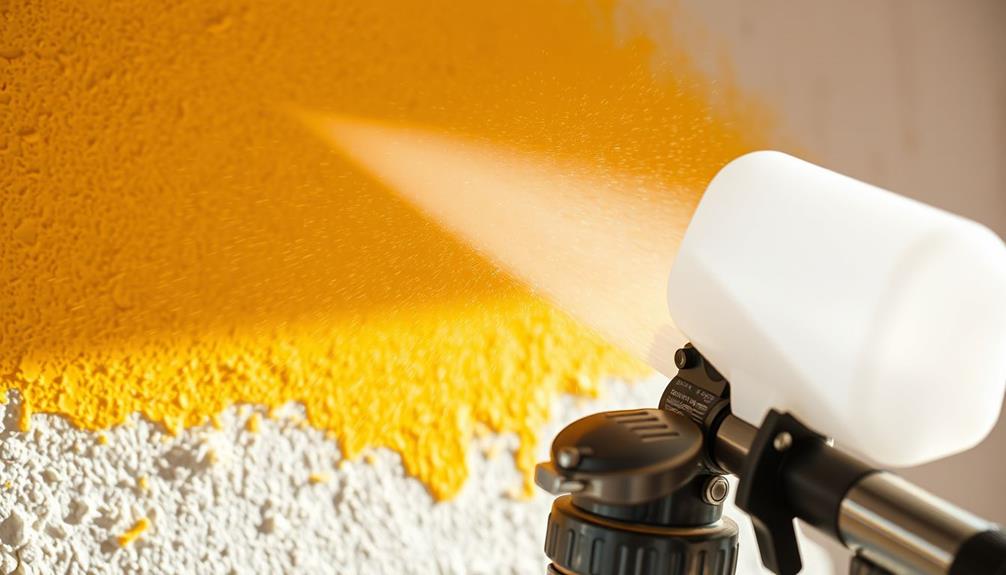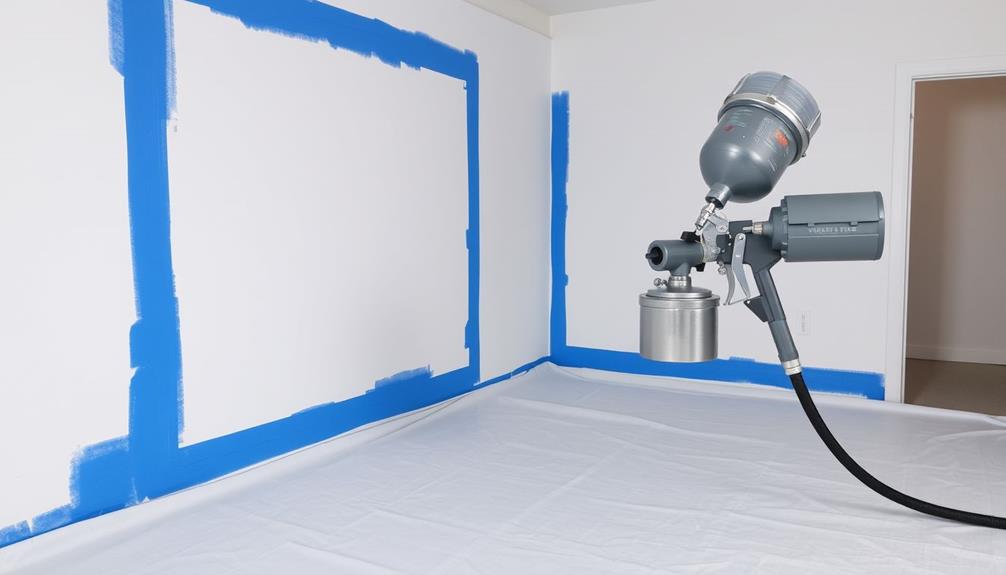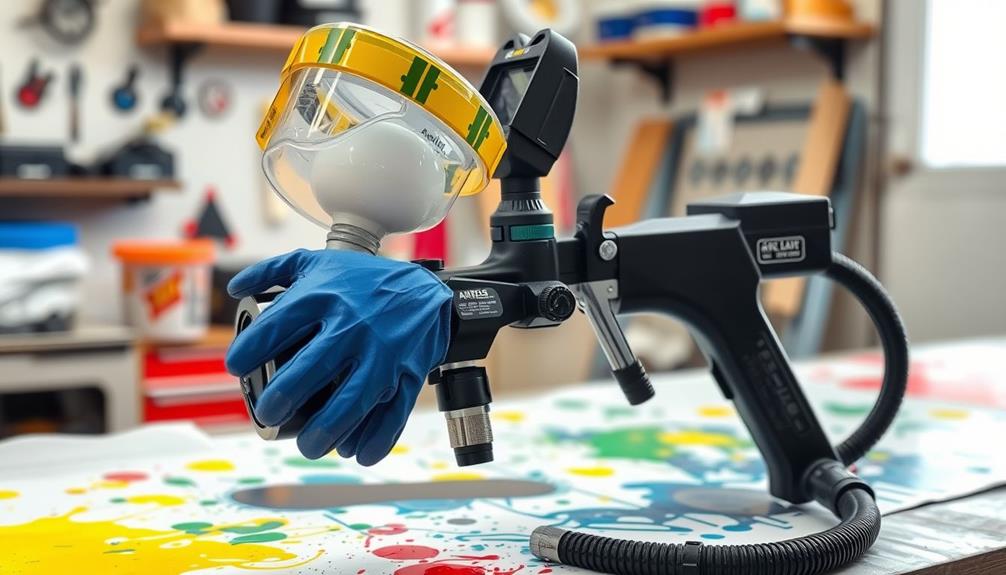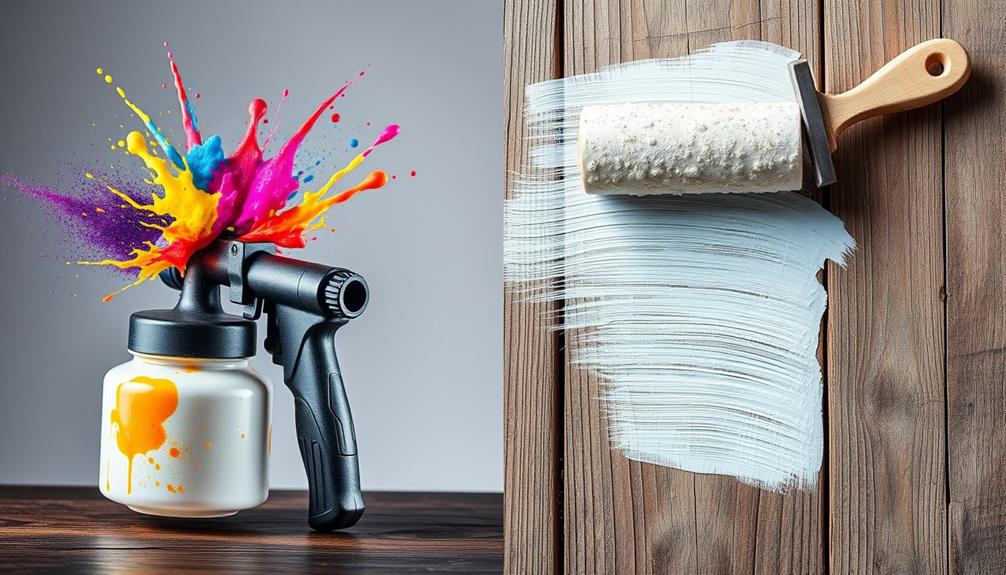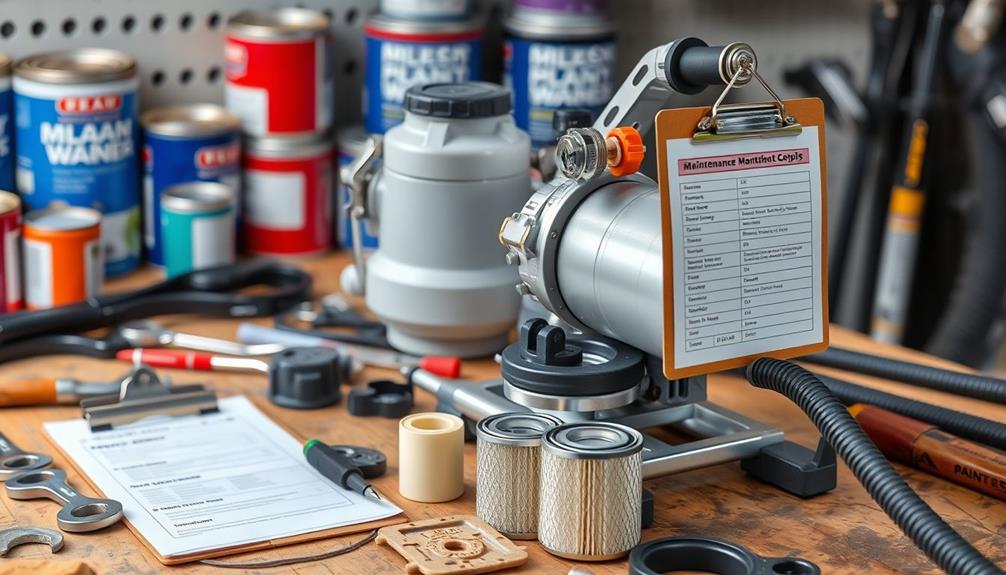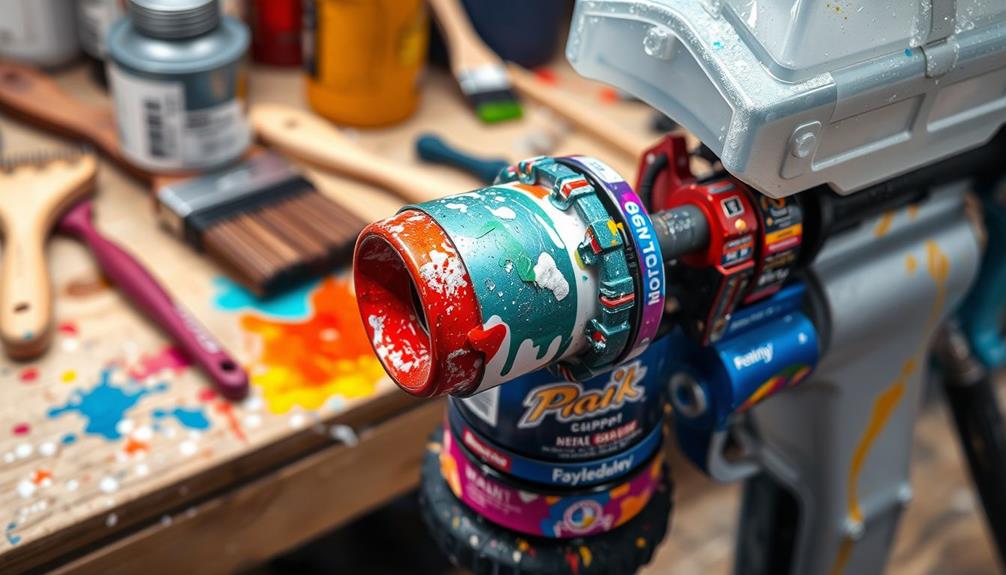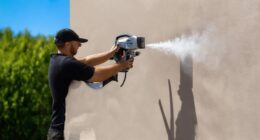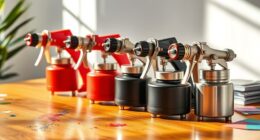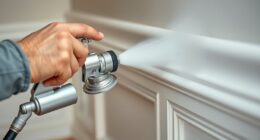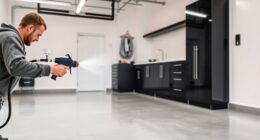To achieve even coverage with your airless paint sprayer, focus on a few key techniques. Maintain a steady distance of 12 to 16 inches from the surface to optimize paint distribution. Hold the gun perpendicular to the surface and trigger it only while moving to avoid paint buildup. Overlap each stroke by 30-50% for consistent application. Adjust the pressure based on your paint's viscosity; start low to minimize runs and increase gradually. Don't forget to clean and prepare surfaces beforehand. With these tips, you'll be well on your way to a perfect finish, and there's more to explore next!
Key Takeaways
- Maintain a distance of 12-16 inches from the surface for uniform coverage and to prevent runs.
- Overlap each stroke by 30-50% to ensure even coverage and eliminate visible lines.
- Hold the spray gun perpendicular to the surface to optimize paint distribution and achieve a smooth finish.
- Adjust pressure settings based on paint viscosity to achieve a consistent spray pattern without runs or drips.
- Trigger the spray gun only while in motion to control material application and avoid excessive buildup.
Practice Techniques
Before diving into painting, it's smart to practice with water to get a feel for your airless paint sprayer. This initial step helps you master spray gun control, ensuring you're comfortable with the mechanics before you tackle a real project.
Familiarizing yourself with specific techniques is vital for achieving an even finish. Find a safe practice area, like a garage door or cardboard, where you can hone your skills without the stress of affecting a final surface.
Follow the startup procedures from your sprayer's manual, including engaging the gun trigger safety before you install any spray tips. As you practice your spraying, maintain a consistent distance of about 12 inches from the surface. This distance helps you develop a steady hand and prevents overspraying, which can ruin your work.
While practicing, aim to overlap each pass by 50% to achieve even coverage. This technique reinforces the importance of consistent movement, allowing you to understand how to properly trigger the gun for the best results.
Experiment with different spray settings, but remember that mastering these practice techniques is essential for successful painting with an airless spray gun. With each session, you'll build confidence and skill, setting yourself up for a flawless finish.
Pressure Setting Adjustment
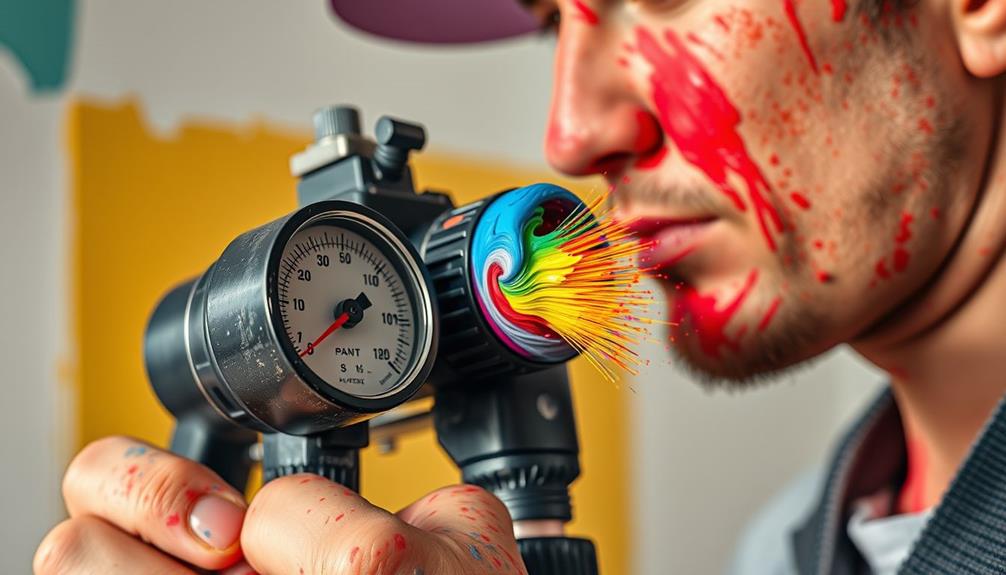
When adjusting the pressure on your airless paint sprayer, you'll want to find the ideal level to achieve a smooth spray pattern.
Utilizing the Graco FFLP Fine Finish Low Pressure Reversible Tip can help you reduce overspray and improve control.
Start low and increase the pressure gradually to avoid runs or drips, especially with thicker paints.
Testing on cardboard before hitting the actual surface will help you fine-tune the settings for consistent results.
Optimal Pressure Levels
Achieving ideal pressure levels is vital for effective airless paint spraying. For those looking to enhance their home aesthetics, breathtaking destinations promise adventure and luxury in painting projects.
To guarantee ideal pressure levels, adjust the pressure control knob based on the paint's viscosity. Heavier-bodied paints require higher pressure, while thinner materials need lower settings to prevent overspray. Start with a low pressure and gradually increase it until you see a full, even spray pattern.
Before you begin your project, test the spray pattern on cardboard. This step helps you fine-tune your pressure settings, confirming proper atomization and consistent paint coverage. A correctly set pressure will show no runs in the spray pattern, indicating an even coat of paint without excess material buildup.
It's also essential to regularly inspect and replace worn spray tips. The correct tip size and condition greatly impact the required pressure settings for ideal results.
Pressure Adjustment Techniques
Pressure adjustment is crucial for maximizing the performance of your airless paint sprayer. Start by adjusting the pressure control knob based on the paint viscosity and surface type.
Consider the importance of using proper critical items for a home cleaning kit to guarantee a clean workspace, as any debris can affect the spray finish. Begin with a low pressure setting and gradually increase it until you achieve a consistent spray pattern without runs. Testing the spray pattern on a piece of cardboard can help you fine-tune your pressure setting, guaranteeing proper atomization and even paint coverage before you tackle the actual surface.
Maintain a spray distance of 12-15 inches, as this ideal distance prevents paint runs and excessive overspray. Lower pressure settings help preserve the fan pattern while minimizing waste, resulting in material cost savings.
Remember, the size of your spray tip directly influences the required pressure for effective paint application, so regularly check and replace worn tips.
Proper gun control is crucial throughout this process—steady hands and deliberate movements will enhance your results. By applying these pressure adjustment techniques, you'll guarantee a flawless finish and maximize the efficiency of your airless paint sprayer.
Impact on Spray Pattern
Proper pressure adjustment directly shapes the spray pattern you achieve with your airless paint sprayer. By fine-tuning the pressure control knob, you can maintain a controlled fan pattern, which helps reduce overspray and enhances paint coverage.
Additionally, selecting the right garage door openers can greatly improve your home's security while you focus on your painting project. Testing your spray pattern on cardboard before application allows you to verify proper atomization and consistent coverage, making adjustments easier.
When working with heavier-bodied paints, you might need to increase the pressure, but be cautious. Excessive pressure can lead to runs and an uneven finish. It's crucial to pair the correct spray tip size with your pressure setting; using a tip that's too large can result in excess paint application and an inconsistent finish.
Regularly monitoring and adjusting your pressure settings during the spraying process is key. This adaptability allows you to accommodate various surface types and paint viscosities, verifying smoother application and even coverage.
With effective spray gun control, you can achieve the desired results and transform your painting project into a professional-looking finish. Remember, the right pressure setting can make all the difference in your spray pattern and overall success.
Spraying Success Tips
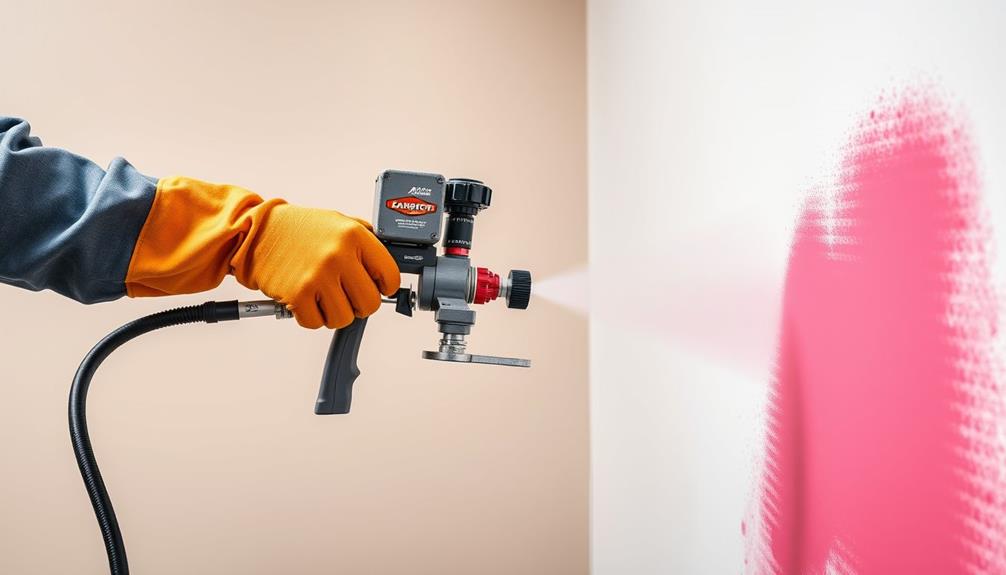
Mastering the art of airless paint spraying requires a blend of technique and finesse. To achieve an even finish, maintain a consistent distance of about 12 inches from the surface. This distance helps you maintain an even spray pattern and prevents runs or overspray.
When you spray, always keep the gun perpendicular to the surface to maximize paint distribution and create clean edges, particularly when cutting in. Additionally, understanding your dog's health needs can enhance your overall care routine, just like mastering painting techniques improves your project outcomes.
As you apply the paint, trigger the spray gun only while in motion. This technique helps control the amount of material applied, minimizing drips and guaranteeing a smoother application. Additionally, adjust your pressure control knob to find the best setting—start with a lower pressure and gradually increase it to avoid runs while still achieving a full spray pattern.
Overlap each pass by 50% to guarantee seamless coverage, eliminating visible lines between strokes. Pay attention to your spray speed; moving too fast can create uneven coverage, while too slow can lead to excessive buildup.
Essential Safety Measures
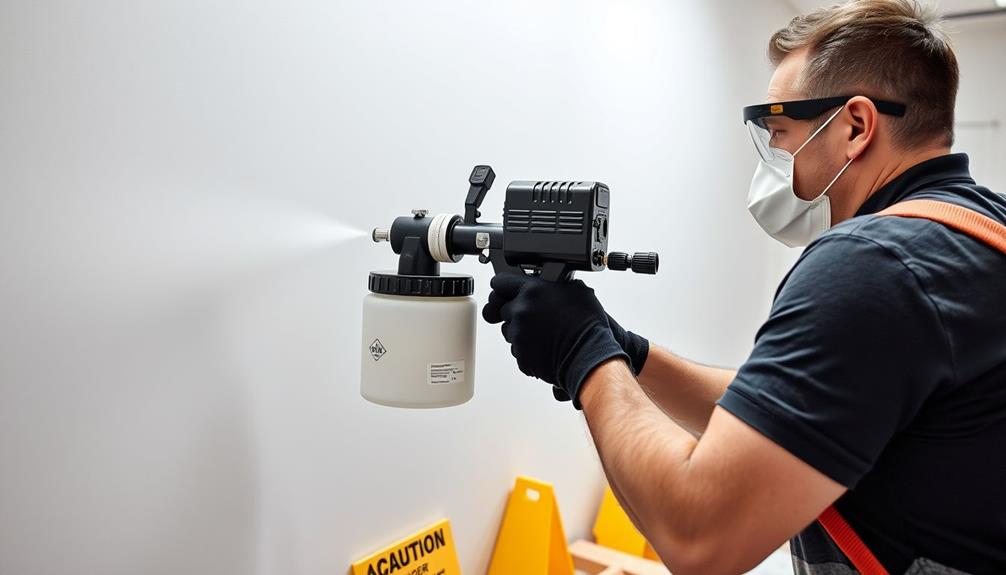
Safety should always be your top priority when using an airless paint sprayer. Start by wearing a respirator mask and safety goggles to protect yourself from harmful paint fumes and overspray.
Additionally, implementing safety measures can protect your home and belongings, similar to how effective home security systems deter potential threats. Don't forget to invest in quality protective equipment like gloves, as these will help shield your skin from potential paint splatters and drips.
It's essential to wear long-sleeved clothing and closed-toe shoes for added skin protection during your project. Guaranteeing proper ventilation in your workspace will greatly reduce the risks associated with inhaling harmful particles and fumes. Open windows and doors or use fans to create airflow while you work.
Compliance with legal safety requirements regarding protective equipment is mandatory, so never skip these precautions.
Take regular breaks during your operation to minimize exposure to the fumes. This not only enhances your well-being but also guarantees a safer working environment throughout the project.
Equipment and Nozzle Selection
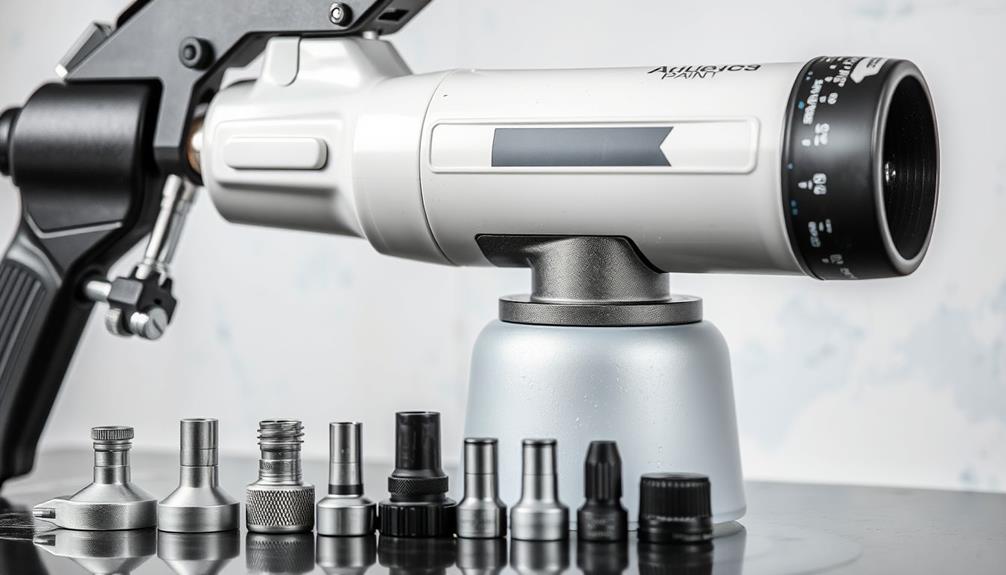
How do you guarantee the finest results when using an airless paint sprayer? The key lies in selecting the right equipment and nozzle. Start by choosing the correct spray gun and nozzle size; smaller tips provide finer detail, while larger tips deliver thicker coatings and broader coverage. Additionally, the nozzle's angle affects the spray width, ranging from 0° for narrow sprays to 80° for wider applications.
To help you understand better, here's a quick reference table:
| Nozzle Size | Application Type |
|---|---|
| 0.015" | Fine detail work |
| 0.019" | General-purpose coating |
| 0.025" | Thick coatings and primers |
The bore diameter controls the paint flow, so match it to the paint viscosity to avoid clogging. Don't forget about filter selection; coarser filters work for thicker materials, while finer filters promote smooth flow for lighter paints. Regularly inspect and replace worn nozzles for consistent performance, as they can lead to uneven coverage. By following these spray techniques, you'll achieve prime results in your airless spraying projects.
Surface Preparation Steps
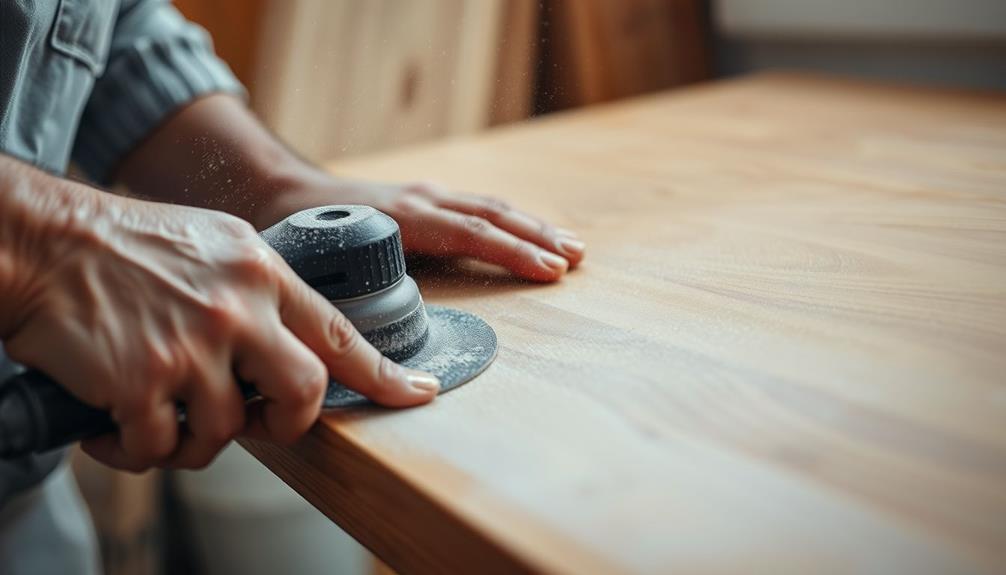
Before you start painting, proper surface preparation is vital for achieving a professional finish. Begin by thoroughly cleaning the surface to remove dirt, grease, and loose materials. This step guarantees proper paint adhesion and a smooth finish.
If you're working with glossy areas, sand them lightly to enhance adhesion. For any cracks or holes, fill them with spackle and sand smooth once it's dried. Additionally, verify that the area is free from any strong odors that might affect your painting environment, as certain scents can be overwhelming. Understanding Toxicity to Cats From Ferns can also be beneficial if you're working in a space shared with pets.
Next, lightly sand the entire surface and remove dust to prevent future paint chipping or peeling. It's also important to inspect the surface for any imperfections that might affect your results.
Once the surface is prepped, it's time to prepare your paint. Always strain it through a filter before pouring it into the sprayer. This prevents clogging of the spray tips and guarantees an even paint flow during application.
Mastering Spraying Techniques

Mastering spraying techniques is crucial for achieving a flawless finish with your airless paint sprayer. To begin, maintain a proper distance of 12 to 16 inches from the surface. This guarantees uniform paint coverage and prevents overspray.
When you're ready to paint, hold the spray gun perpendicular to the surface; this optimizes paint distribution and helps avoid streaks. Additionally, consider the acoustics of your workspace, as sound can impact your concentration during the spraying process and lead to better results when you're focused on your technique. Sound system configuration can enhance your overall experience while working.
As you start, trigger the spray gun only while in motion. This technique prevents paint buildup and guarantees a smooth, even coat. Always start your movement before you trigger the spray gun and release it before stopping to eliminate drips and enhance your finish quality.
To achieve seamless coverage, overlap each stroke by about 50%. This will minimize any gaps and guarantee consistent application. Pay attention to your gun position throughout the spraying process, as it plays a crucial role in your overall results.
Optimizing Application Strategies
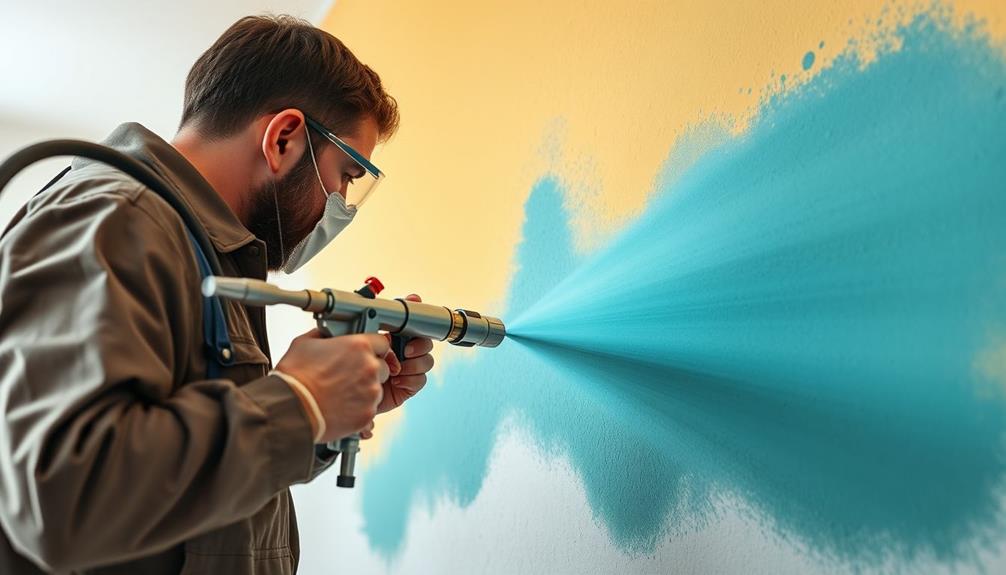
Optimizing your application strategies can markedly enhance your painting results and efficiency. Start by properly preparing your surfaces and confirming they're clean and dry.
When using your spray gun, choose the right tip size for your project; this helps with achieving even coverage. As you begin spraying, maintain a consistent speed. This control is essential in preventing paint patches and guaranteeing uniform application. Additionally, consider the environment in which you're painting; factors such as humidity and temperature can impact the drying time and finish of your paint. For instance, thrilling slides and relaxing rivers in water parks can serve as a backdrop for your projects, reminding you of the importance of a well-prepared area.
Spray corners and edges first, as this establishes a solid base for larger areas and minimizes paint buildup. Keep the gun at a uniform distance of 10 to 15 inches from the surface. This distance is key for ideal paint distribution and reducing overspray.
To achieve streak-free results, overlap each stroke by approximately 30-50%. This overlapping technique not only enhances the overall appearance but also guarantees every spot receives adequate paint.
Additional Resources and Support
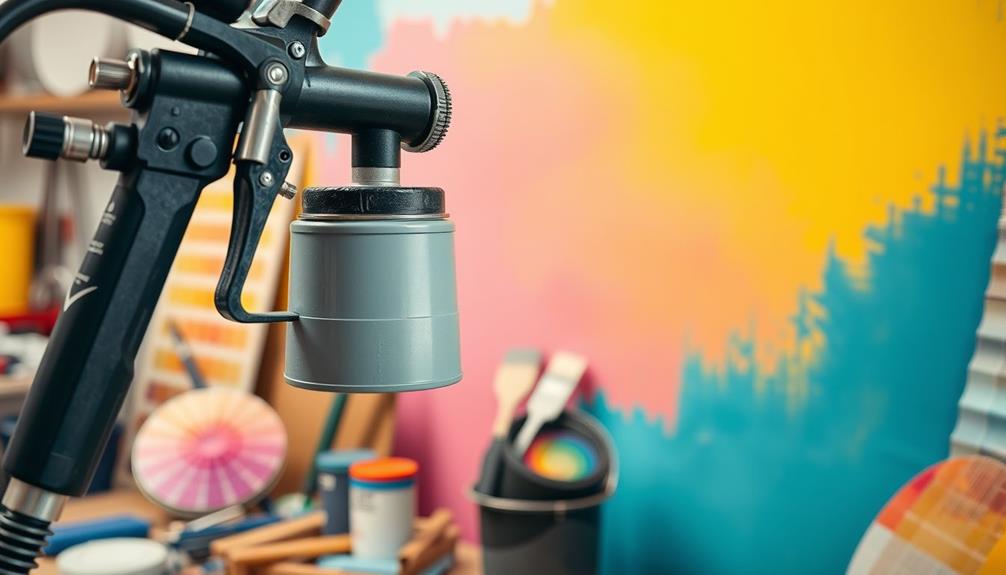
When you're diving into airless paint spraying, having the right resources and support can make all the difference. To achieve even coverage and master your technique, access various forms of assistance tailored to your needs.
For immediate inquiries about airless paint sprayers, you can call 888-541-9788 for 24/7 support. If you prefer detailed guidance, email support is an excellent option for troubleshooting and equipment usage.
Choosing the right tip is essential for your project, and local retailers can help you select the proper airless paint sprayer model and accessories.
Don't forget to equip yourself with protective equipment, as safety should always be a priority when working with high-pressure sprayers.
Additionally, explore instructional videos and manuals to enhance your skills and confidence with paint strokes. These resources can provide valuable insights and tips that will improve your overall spraying technique.
Finally, take a moment to review the company's privacy notice and terms of service online, ensuring you understand your rights while seeking support.
With these resources at your fingertips, you'll be well-equipped to tackle your airless painting projects successfully.
Frequently Asked Questions
How Do You Get Even Coverage With a Paint Sprayer?
To get even coverage with a paint sprayer, maintain a consistent distance from the surface, overlap strokes by about 50%, keep your hand steady, and adjust settings based on the material for best results.
Why Is My Airless Paint Sprayer Not Spraying Evenly?
Your airless paint sprayer might not be spraying evenly due to a clogged tip, incorrect pressure settings, or an improper spray tip. Check these factors, maintain your distance, and guarantee proper overlap for better results.
How Do You Paint Evenly With a Sprayer?
To paint evenly with a sprayer, maintain a consistent distance from the surface, overlap strokes, and keep the gun perpendicular. Always test your settings first to guarantee a smooth, uniform finish before starting.
What Is the Number One Rule When Using Airless Spray Guns?
When you dance with airless spray guns, remember the golden rule: maintain a steady distance of 12 to 16 inches from your surface. This guarantees even coverage and helps avoid the chaos of overspray.
Conclusion
To sum up, mastering airless paint sprayer techniques isn't just about the equipment; it's about understanding the science behind even coverage. Did you know that adjusting your pressure can drastically change the finish? By practicing your skills and paying attention to surface prep, you can achieve professional results. So, embrace these techniques and see how they transform your projects. With the right approach, you'll make every spray count and enjoy the satisfaction of a flawless finish.
